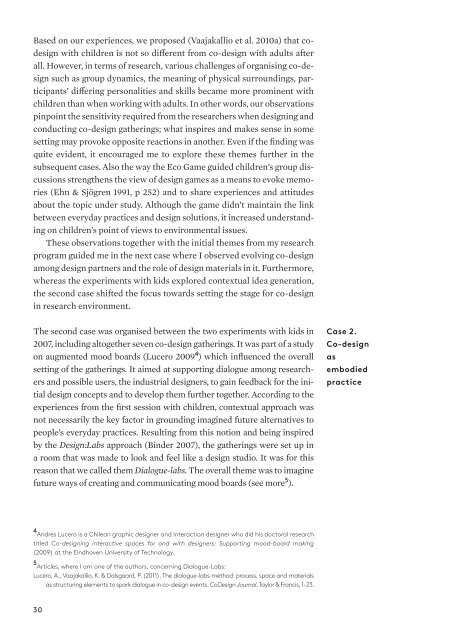Design games as a tool, a mindset and a structure Kirsikka Vaajakallio
Design games as a tool, a mindset and a structure Kirsikka Vaajakallio
Design games as a tool, a mindset and a structure Kirsikka Vaajakallio
Create successful ePaper yourself
Turn your PDF publications into a flip-book with our unique Google optimized e-Paper software.
B<strong>as</strong>ed on our experiences, we proposed (<strong>Vaajakallio</strong> et al. 2010a) that codesign<br />
with children is not so different from co-design with adults after<br />
all. However, in terms of research, various challenges of organising co-design<br />
such <strong>as</strong> group dynamics, the meaning of physical surroundings, participants’<br />
differing personalities <strong>and</strong> skills became more prominent with<br />
children than when working with adults. In other words, our observations<br />
pinpoint the sensitivity required from the researchers when designing <strong>and</strong><br />
conducting co-design gatherings; what inspires <strong>and</strong> makes sense in some<br />
setting may provoke opposite reactions in another. Even if the finding w<strong>as</strong><br />
quite evident, it encouraged me to explore these themes further in the<br />
subsequent c<strong>as</strong>es. Also the way the Eco Game guided children’s group discussions<br />
strengthens the view of design <strong>games</strong> <strong>as</strong> a means to evoke memories<br />
(Ehn & Sjögren 1991, p 252) <strong>and</strong> to share experiences <strong>and</strong> attitudes<br />
about the topic under study. Although the game didn’t maintain the link<br />
between everyday practices <strong>and</strong> design solutions, it incre<strong>as</strong>ed underst<strong>and</strong>ing<br />
on children’s point of views to environmental issues.<br />
These observations together with the initial themes from my research<br />
program guided me in the next c<strong>as</strong>e where I observed evolving co-design<br />
among design partners <strong>and</strong> the role of design materials in it. Furthermore,<br />
where<strong>as</strong> the experiments with kids explored contextual idea generation,<br />
the second c<strong>as</strong>e shifted the focus towards setting the stage for co-design<br />
in research environment.<br />
The second c<strong>as</strong>e w<strong>as</strong> organised between the two experiments with kids in<br />
2007, including altogether seven co-design gatherings. It w<strong>as</strong> part of a study<br />
on augmented mood boards (Lucero 2009 4 ) which influenced the overall<br />
setting of the gatherings. It aimed at supporting dialogue among researchers<br />
<strong>and</strong> possible users, the industrial designers, to gain feedback for the initial<br />
design concepts <strong>and</strong> to develop them further together. According to the<br />
experiences from the first session with children, contextual approach w<strong>as</strong><br />
not necessarily the key factor in grounding imagined future alternatives to<br />
people’s everyday practices. Resulting from this notion <strong>and</strong> being inspired<br />
by the <strong>Design</strong>:Labs approach (Binder 2007), the gatherings were set up in<br />
a room that w<strong>as</strong> made to look <strong>and</strong> feel like a design studio. It w<strong>as</strong> for this<br />
re<strong>as</strong>on that we called them Dialogue-labs. The overall theme w<strong>as</strong> to imagine<br />
future ways of creating <strong>and</strong> communicating mood boards (see more 5 ).<br />
C<strong>as</strong>e 2.<br />
Co-design<br />
<strong>as</strong><br />
embodied<br />
practice<br />
4 Andres Lucero is a Chilean graphic designer <strong>and</strong> interaction designer who did his doctoral research<br />
titled Co-designing interactive spaces for <strong>and</strong> with designers: Supporting mood-board making<br />
(2009) at the Eindhoven University of Technology.<br />
5 Articles, where I am one of the authors, concerning Dialogue-Labs:<br />
Lucéro, A., <strong>Vaajakallio</strong>, K. & Dalsgaard, P. (2011). The dialogue-labs method: process, space <strong>and</strong> materials<br />
<strong>as</strong> structuring elements to spark dialogue in co-design events. Co<strong>Design</strong> Journal. Taylor & Francis, 1–23.<br />
30
















